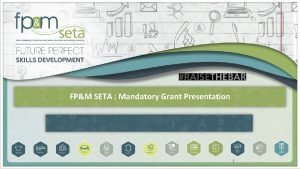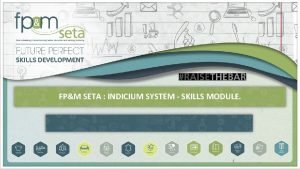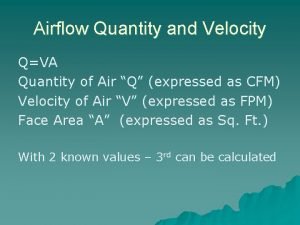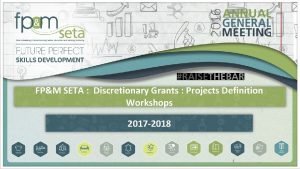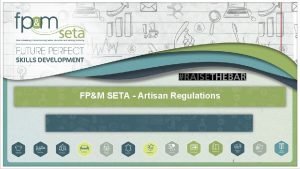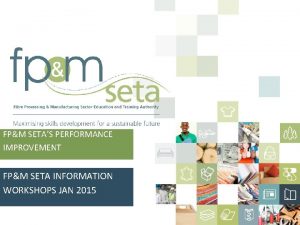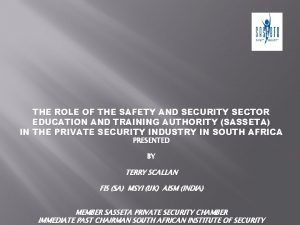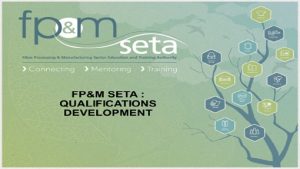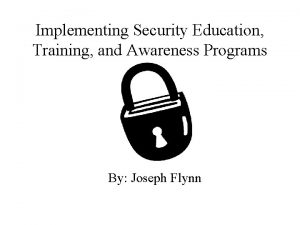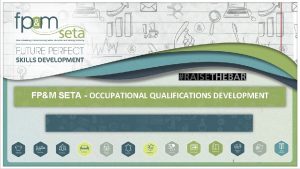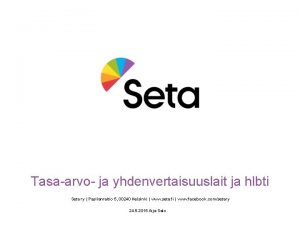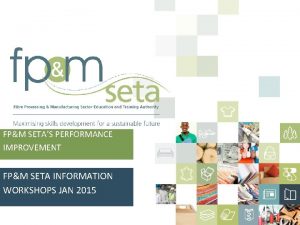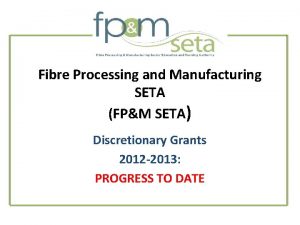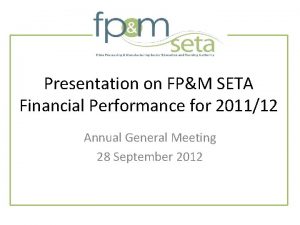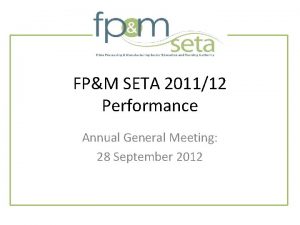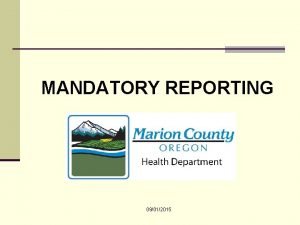FPM SETA Mandatory Grant Presentation 1 Mandatory Grants






























- Slides: 30

FP&M SETA : Mandatory Grant Presentation 1

Mandatory Grants

Mandatory Grants

� � SETA Grant Regulations

SETA Grant Regulations § Distribution of skills development levy income

SETA Grant Regulations The intention of Mandatory Grants is to incentivize employers to: § § plan & implement training for their employees create training and work experience opportunities for unemployed people § Mandatory Grant Applications – Submission due by 30 April 2017 – Better alignment with skills development and financial year – Enhanced SETA planning cycle • SSP Annual Update • Earlier Discretionary Funding Windows

SETA Grant Regulations § Mandatory Grants - - Increased monitoring of WSP implementation against Board criteria • Criteria for approval • Evidence requirements • Quality & accuracy standards for WSPs & ATRs Evidence of consultation and sign-off by labour representative (unless explanation is provided)

SETA Grant Regulations § Assisting Small Enterprises - Support to small enterprises require more emphasis - Simplified mandatory and discretionary grant application processes - Simplified format for reporting on PIVOTAL training - Enhanced processing of grant payments due to small enterprises - Projects designed to address skills needs of small enterprises

Workplace Skills Planning

Workplace Skills Planning § The construction of a WSP plays a major role in a number of vital areas - - Management and employees enter into discussions regarding skills planning in the workplace. - Skills available and skills gaps are identified and discussed in a positive way. - Management has a platform to share the company’s goals with employees, who in turn gain better understanding and more commitment to the process of achieving them. - Companies begin to uncover talents and skills they did not know they had available.

Workplace Skills Planning § Steps to follow when compiling your WSP/ATR: 1. Form a Skills Development Committee (SDC) 2. Nominate an internal or external Skills Development Facilitator (SDF) 3. Identify long-term goals for an organisation 4. Focus on key skills needs (critical and scarce skills) 5. Determine current employee skills and/or competencies by conducting a skills audit 6. Conduct a training needs analysis 7. Develop the WSP 8. Report on training conducted during the previous year (annual training report) § The final content of the WSP should be the result of meaningful interaction between employers and employees, using current structures, SDCs or union/management structures to obtain input.

� � � Workplace Skills Planning Step 1: Form a Skills Development Committee (SDC) § Membership - Stakeholders (management, employees, union representatives) - Where there is a trade union presence, nominated representatives should serve on the SDC. - Where there is no representative trade union, employees should nominate representatives - Members should represent different functional areas and occupational categories - Equity (gender, race, disability) should be considered § Responsibilities - The SDC must meet regularly and must record the minutes of the meetings as proof of consultation - The SDC must collectively deliver and contribute to the WSP and ATR - Appointment of a SDF; and - Complete and sign-off the WSP and ATR (where applicable)

Workplace Skills Planning Step 2: Nominate an internal or external Skills Development Facilitator (SDF) § All employers must appoint an SDF to comply with the provisions of the Skills Development Act. § The appointment of the SDF is key to claiming of relevant grants and ensuring the implementation of the WSP during the training year. § The SDF’s role includes - - Assisting the employer to develop a WSP; - Submitting the WSP to the SETA; - Advising the employer on implementation of the WSP; - Assisting the employer to draft the ATR in line with the approved WSP and grant funding regulations; - Advising the employer on quality assurance requirements as set by the SETA; and - Liaising with the SETA on behalf of the company.

� � � � Workplace Skills Planning Step 2: Nominate an internal or external Skills Development Facilitator (SDF) § Requirements for the appointment of the SDF - An employer may choose to appoint either an internal SDF or make use of an external training and development consultant § When appointing an SDF for the company, you are advised to undertake the following - There should be consultation with members of the SDC; and - The SDF must attend all meetings of the SDC. § You are encouraged to send an SDF on a short course relating to skills development facilitation, if they do not have the requisite training in this area.

Workplace Skills Planning Step 3: Identify long-term goals for an organisation § The business’ strategic priorities help to identify long-term skills development goals for the organisation. When planning your training you should include the vision, mission and values of the organisation as these assist with the formulation of your strategy (key objectives). § Employees need to enable the organisation to achieve its objectives. § The SDF must identify the learning/development interventions needed for staff to assist the organisation with achieving this aim. § When detailing strategic business and/or skill priorities, make linkages to business and employment equity plans. Step 4: Focus on key skills needs (critical and scarce skills) § The WSP should cover all planned skills development training, including learnerships. § Identify key skills needs using the organisation’s business plan and the FP&M Sector Skills Plan. The SSP contains a list of scarce and critical skills per sub-sector.

Workplace Skills Planning Step 5: Determine current employee skills and/or competencies by conducting a skills audit § It is necessary to determine the current employee skills and/or competencies profile by conducting a skills audit. § The skills audit should reflect all the skills and competencies of the workforce, whether obtained through formal learning programme interventions (qualifications) or work experience / in-house training. Step 6: Conduct a training needs analysis § The future skills profile can be developed by using a training needs analysis based on future business needs as well as the SETA Sector Skills Plan. Step 7: Develop the WSP § Identify the gaps between current and required future skills profiles and identify skills development interventions to address these priorities. § This should be reflected in the WSP.

Workplace Skills Planning § The final content of the WSP should be the result of meaningful interaction between employers and employees, using current structures, SDCs or union/management structures to obtain input. Step 8: Report on training conducted during the previous year (annual training report - ATR) § The ATR must reflect all training that was conducted during the previous year including - External training - Internal or in-house training - Work integrated learning - Adult Education and training § The SDF must keep records of training conducted e. g. invoices from external providers, attendance registers for in-house training conducted, learner results etc. § The SETA may select any organisation as part of an audit sample when conducting monitoring and evaluation visits.

Workplace Skills Planning The overall objective is - § To create a workforce: - empowered with the necessary skills, knowledge and recognized qualifications - enabled to access decent employment - qualified to contribute to the organisation’s productivity and competitiveness in the global market - capable to adapt to changing technologies and labour market demands § To address the needs of the unemployed - increased participation of youth, women, disabled and other disadvantaged sections - empowered with the necessary skills, knowledge and recognized qualifications - increased employability (in industry and self-employment) - increased placement and work experience

Workplace Skills Planning § § Provide information to the FP&M SETA on: - The geographic profile - The demographic profile - The current and predicted skills needs and gaps - Current skills development practices - Further interventions required Enable the SETA to - Render support - Enhance Sector Skills Planning & research initiatives.

Mandatory Grant Criteria § A levy paying employer claiming a mandatory grant must meet the eligibility criteria for the payment of a mandatory grant § An eligible employer - - has registered for skills development levies; - has paid the levies in the prescribed manner (minimum threshold R 500 k per annum); - has submitted a WSP / PIVOTAL Plan and ATR/PIVOTAL Report within the prescribed timeframes (30 April) that contributes to the relevant SETA SSP - has submitted an Annual Training Report and/or PIVOTAL Training Report, demonstrating some alignment to the previous year’s WSP and/or PIVOTAL Plan

Mandatory Grant Criteria - has provided evidence that the WSP and ATR have been subjected to consultation with the recognised trade unions and/or employee forum (medium/large companies) eg. Labour sign-off, Committee Membership List, Minutes of Meeting or has submitted an explanation § It is the responsibility of SDF (acting on behalf of the employer) to ensure that the correct levy number is quoted on applications

Mandatory Grant Application § The mandatory grant application consist of the following important sections: - Organisational information - Banking details - Employment summary and Provincial Breakdown • Provides information on the current workforce (including learners) - Workplace Skills Plan • PIVOTAL plan o Planned implementation of PIVOTAL learning programmes e. g. apprenticeships, learnerships, credit bearing skills programmes, work integrated learning, bursary programmes (post school / tertiary qualifications at TVETs/ HEIs) • Non-PIVOTAL plan o Planned implementation of other learning programmes e. g. non-credit bearing skills programmes, in-house training (health and safety, HIV/Aids awareness)

Mandatory Grant Application § Annual Training Report - PIVOTAL training report • Actual implementation of PIVOTAL learning programmes e. g. apprenticeships, learnerships, credit bearing skills programmes, work integrated learning, bursary programmes (post school / tertiary qualifications at TVETs/ HEIs) - Non-PIVOTAL training report • Actual implementation of other learning programmes e. g. non-credit bearing skills programmes, in-house training (health and safety, HIV/Aids awareness) • Adult Education and Training Plan • Adult Education and Training Report • Training Committee (list of members) – for medium and large firms only • Sign-off (Authorisation page) • Research Annexure

Mandatory Grant Application § § § ATR and/or Pivotal Report must reflect all training conducted - During April to March (of the previous financial year) - Internally or Externally The WSP and/or Pivotal Plan must reflect all planned training - Internally or Externally - Planned for April to March (of the current financial year) Important to remember - No Pivotal Plan/Report – no discretionary grants for medium/large firms

Mandatory Grant Application § § The WSP/ATR must be duly authorised and signed-off by: - The Internal Training Committee / Skills Development Committee including designated labour representative o Firms employing 50 or more employees; or The Owner / Chief Executive and designated employee representative o Firms employing less than 50 employees;

Mandatory Grant Application § Deadline for submissions: - on/or before 30 April : § § Applications to be submitted electronically via MIS Scanned authorisation page and scanned current proof of banking details to be upload to MIS - Original proof of banking details will be required from first time applicants or if an applicant’s banking details have changed since the previous year’s submission. § § § Assistance will be supplied to applicants unable to access the MIS on request Requests for extension: Anticipated delays – by 31 March o subject to approval by Board

Pivotal Reporting

Contact Details

Questions and Answers 29

Thank You
 Seta business funding
Seta business funding Fpm seta login
Fpm seta login Fpm seta
Fpm seta Financial performance management fpm
Financial performance management fpm Fume hood sash height
Fume hood sash height Q = va
Q = va Fpm landscapes
Fpm landscapes Tabela de coeficiente do fpm
Tabela de coeficiente do fpm Grant proposal presentation
Grant proposal presentation Zenzele myeza
Zenzele myeza Seta
Seta Discretionary grants definition
Discretionary grants definition Seta acronym
Seta acronym Seta vermelha
Seta vermelha Seta piel de corzo
Seta piel de corzo Seta can play the guitar
Seta can play the guitar Fp&m seta qualifications
Fp&m seta qualifications Lavorazione della seta fasi
Lavorazione della seta fasi Sasseta ceo
Sasseta ceo Projeto animais
Projeto animais Motor seta
Motor seta Services seta funding
Services seta funding Seta ready content development
Seta ready content development Define security education
Define security education Agriculture seta
Agriculture seta Seta de olivo
Seta de olivo Seta plant
Seta plant Indicium
Indicium Anthocerotopsida contoh
Anthocerotopsida contoh Seta koulutus
Seta koulutus Seta plant
Seta plant
